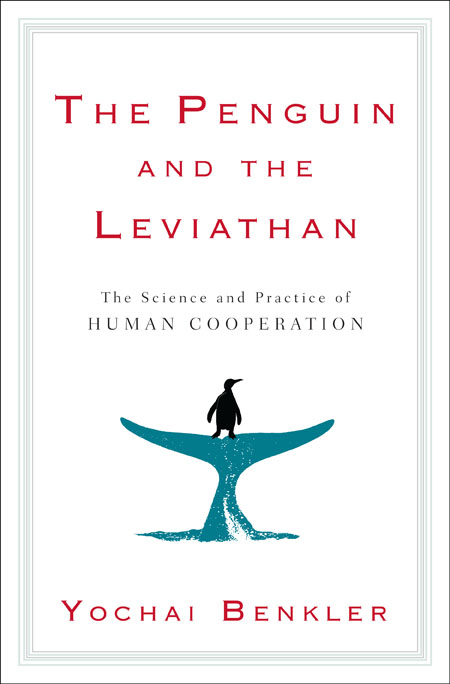Yochai Benkler: The Penguin and the Leviathan: How Cooperation Triumphs Over Self-Interest (2011)
Filed under book | Tags: · biology, business, collaboration, economics, floss, neuroscience, politics, psychology, society, sociology, software, technology, web

What do Wikipedia, Zip Car’s business model, Barack Obama’s presidential campaign, and a small group of lobster fishermen have in common? They all show the power and promise of human cooperation in transforming our businesses, our government, and our society at large. Because today, when the costs of collaborating are lower than ever before, there are no limits to what we can achieve by working together.
For centuries, we as a society have operated according to a very unflattering view of human nature: that, humans are universally and inherently selfish creatures. As a result, our most deeply entrenched social structures – our top-down business models, our punitive legal systems, our market-based approaches to everything from education reform to environmental regulation – have been built on the premise that humans are driven only by self interest, programmed to respond only to the invisible hand of the free markets or the iron fist of a controlling government.
In the last decade, however, this fallacy has finally begun to unravel, as hundreds of studies conducted across dozens of cultures have found that most people will act far more cooperatively than previously believed. Here, Harvard University Professor Yochai Benkler draws on cutting-edge findings from neuroscience, economics, sociology, evolutionary biology, political science, and a wealth of real world examples to debunk this long-held myth and reveal how we can harness the power of human cooperation to improve business processes, design smarter technology, reform our economic systems, maximize volunteer contributions to science, reduce crime, improve the efficacy of civic movements, and more.
For example, he describes how:
• By building on countless voluntary contributions, open-source software communities have developed some of the most important infrastructure on which the World Wide Web runs
• Experiments with pay-as-you-wish pricing in the music industry reveal that fans will voluntarily pay far more for their favorite music than economic models would ever predic
• Many self-regulating communities, from the lobster fishermen of Maine to farmers in Spain, live within self-regulating system for sharing and allocating communal resources
• Despite recent setbacks, Toyota’s collaborative shop-floor, supply chain, and management structure contributed to its meteoric rise above its American counterparts for over a quarter century.
• Police precincts across the nation have managed to reduce crime in tough neighborhoods through collaborative, trust-based, community partnerships.
A must-read for anyone who wants to understand the dynamics of cooperation in 21st century life, The Penguin and the Leviathan not only challenges so many of the ways in which we live and work, it forces us to rethink our entire view of human nature.
Publisher Crown Publishing Group, 2011
ISBN 0307590194, 9780307590190
272 pages
PDF (EPUB)
Comment (0)Nils L. Wallin, Björn Merker, Steven Brown (eds.): The Origins of Music (1999)
Filed under book | Tags: · biology, biomusicology, cognition, ethnomusicology, evolution, language, linguistics, music, music history, music theory, neuroscience, sound recording

What biological and cognitive forces have shaped humankind’s musical behavior and the rich global repertoire of musical structures? What is music for, and why does every human culture have it? What are the universal features of music and musical behavior across cultures? In this groundbreaking book, musicologists, biologists, anthropologists, archaeologists, psychologists, neuroscientists, ethologists, and linguists come together for the first time to examine these and related issues. The book can be viewed as representing the birth of evolutionary biomusicology—the study of which will contribute greatly to our understanding of the evolutionary precursors of human music, the evolution of the hominid vocal tract, localization of brain function, the structure of acoustic-communication signals, symbolic gesture, emotional manipulation through sound, self-expression, creativity, the human affinity for the spiritual, and the human attachment to music itself.
Contributors: Simha Arom, Derek Bickerton, Steven Brown, Ellen Dissanayake, Dean Falk, David W. Frayer, Walter Freeman, Thomas Geissmann, Marc D. Hauser, Michel Imberty, Harry Jerison, Drago Kunej, François-Bernard Mâche, Peter Marler, Björn Merker, Geoffrey Miller, Jean Molino, Bruno Nettl, Chris Nicolay, Katharine Payne, Bruce Richman, Peter J. B. Slater, Peter Todd, Sandra Trehub, Ivan Turk, Maria Ujhelyi, Nils L. Wallin, Carol Whaling.
Publisher MIT Press, 2001
Bradford Books series
ISBN 0262731436, 9780262731430
512 pages
PDF (updated on 2012-8-3)
Comment (1)Irving Massey: The Neural Imagination: Aesthetic and Neuroscientific Approaches to the Arts (2009)
Filed under book | Tags: · aesthetics, art, brain, cognitive science, neural networks, neuroaesthetics, neurons, neuroscience

“Art and technology have been converging rapidly in the past few years; an important example of this convergence is the alliance of neuroscience with aesthetics, which has produced the new field of neuroaesthetics.
Irving Massey examines this alliance, in large part to allay the fears of artists and audiences alike that brain science may “explain away” the arts. The first part of the book shows how neuroscience can enhance our understanding of certain features of art. The second part of the book illustrates a humanistic approach to the arts; it is written entirely without recourse to neuroscience, in order to show the differences in methodology between the two approaches. The humanistic style is marked particularly by immersion in the individual work and by evaluation, rather than by detachment in the search for generalizations. In the final section Massey argues that, despite these differences, once the reality of imagination is accepted neuroscience can be seen as the collaborator, not the inquisitor, of the arts.”
Publisher University of Texas Press, 2009
Cognitive Approaches to Literature and Culture series
ISBN 0292752792, 9780292752795
224 pages
PDF (updated on 2018-8-7)
Comments (2)
